Spin Polarization Oscillations and Coherence Time in the Random Interaction Approach
Abstract
We study the time evolution of the survival probability and the spin polarization of a dissipative nondegenerate two-level system in the presence of a magnetic field in the Faraday configuration. We apply the Extended Gaussian Orthogonal Ensemble approach to model the stochastic system-environment interaction and calculate the survival and spin polarization to first and second order of the interaction picture. We present also the time evolution of the thermal average of these quantities as functions of the temperature, the magnetic field, and the energy-levels density, for ρ(ϵ) ∝ ϵs, in the subohmic, ohmic, and superohmic dissipation forms. We show that the behavior of the spin polarization calculated here agrees rather well with the time evolution of spin polarization observed and calculated, recently, for the electron-nucleus dynamics of Ga centers in dilute (Ga,N)As semiconductors.
1. Introduction
The necessity to maintain the information for long periods of time and the efforts to control and manipulate the electronic spin degrees of freedom led to extensive research activities, such as, among others, the search for the best conditions to keep the spin polarization, as well as new mechanisms to enhance the spin coherence time [1–6]. In spite of abundant empirical knowledge of the spin depolarization rates and the spin coherence times, there is little knowledge of the explicit time evolution of these quantities, as functions of the relevant system-environment interaction parameters. In this paper, we focus on this problem and present a simple calculation of the time evolution of the spin polarization driven by the stochastic interaction of the system and its environment, with good results and few assumptions.
The physics of the two-state systems have been studied since the early days of the quantum theory, and various models and approaches have been proposed and published [7–18]. Attempts to solve completely the models for dissipative two-state systems are generally faced with mathematical complexities. Examples vary from entangled differential equations in master equation approaches [11, 19] to perturbative calculations in the ‘spin-boson’ [14] and the rotating-wave” approximation [16]. Recently the master equation approach [19] was applied to describe the evolution of the electronic and nuclear spin polarizations of interstitial gallium defects, which behave as paramagnetic centers in dilute (Ga,N)As semiconductor that selectively capture electrons with opposite spin, and block the recombination of conduction band electrons with the same spin (which lead to an increase of the lifetime of conduction electrons and bound electrons from picoseconds to nanoseconds). The intricacy of this approach expressed through almost a hundred of coupled nonlinear differential equations (with assumptions on the dissipative interactions) reminds us of the ‘much too intractable (intermediate results) of the spin-boson model’ [15]. In the physics of complex systems, it has been frequently found that some processes are insensitive to the details of the interaction, being only a few “gross properties” relevant to describe them. This feature, which is not new to many body problems, has often been used to construct successful and enlightening approaches in terms of ensembles of stochastic interactions [17, 20–27] that make possible satisfying evaluations of ensemble averages for relevant quantities. We will present here a Gaussian stochastic spin-environment interaction approach that strengthens this idea.
In the master equation approach in [28, 29], the electronic and nuclear spin dynamics, obtained through rather detailed calculations, oscillate as shown in Figure 1 (gray-circles curve). This behavior has been explained as caused by oscillations of the hyperfine interaction of bound electrons with the nuclei. In the stochastic interaction model presented here, we obtain, to second order of the interaction picture, the spin polarization oscillations shown also in Figure 1 and plotted with the continuous (black) curve on top of the gray-circles curve. The agreement of these results supports the suggestion that the loss of coherence and the oscillating time evolution of the spins might be caused by the stochastic nature of trapping and recombination. The complexity of the system makes it also difficult to establish to which extent the observed time evolution is a consequence of a new mechanism or of multiple stochastic and spin-field interactions. In Figure 2 we show the experimental results of the field effect, in the Faraday geometry, on the spin-dependent recombination ratio reported in [5], where the hyperfine interaction was uphold to explain this behavior when interstitial Ga2+ atoms are present in dilute (Ga,N)As semiconductors. On top of these data we plot also our results (see blue curve) for the spin polarization, as function of the magnetic field, driven by the stochastic interaction. The oscillatory behavior of our results might be behind the large dispersion of data in the experimental results shown in Figure 2.
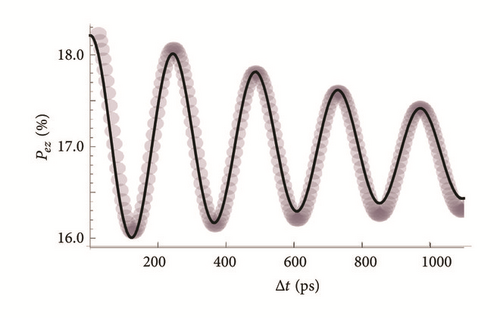
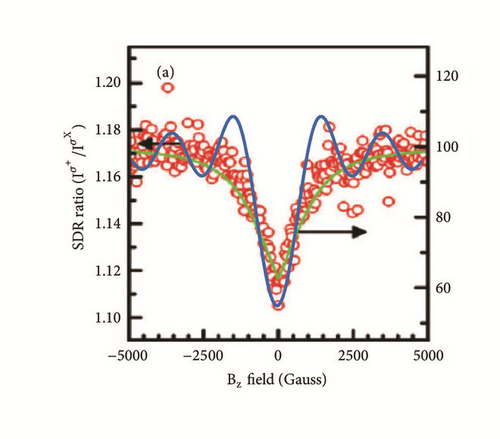
The Hamiltonian in (1) is similar to that of the spin-boson model for a two-state system in the fictitious spin 1/2 picture. In the spin-boson model the environment is modeled as a set of harmonic oscillators and the Hamiltonian describes effectively the tunneling between wells of a double well potential. Some quantities were calculated when appropriate approximations were introduced and the level density was assumed ∝Es (which, depending on whether the exponent s is equal to 1, <1 or >1, corresponds to the so-called ohmic, subohmic and superohmic dissipation forms, respectively).
In the next section we will present the dissipative two-level model. We will present results for the first- and second-order terms of the interaction representation picture in Section 3. In Section 4 we will show some results for the survival probability and for the spin polarization. We discuss some conclusions at the end.
2. The Random Matrix Model and the Survival Probability
3. Time Evolution of the Survival Probability and the Spin Polarization
In this section we present, in detail, results to zeroth and first order of the interaction picture (IP) of the survival probability described in previous section for a spin 1/2 system interacting with a magnetic field in the Faraday configuration and randomly with its environment. The second-order terms of the survival probability are calculated, in detail, in the appendix.
3.1. Survival and Spin Polarization to Zeroth Order of the IP
3.2. Survival and Spin Polarization to First Order of the IP
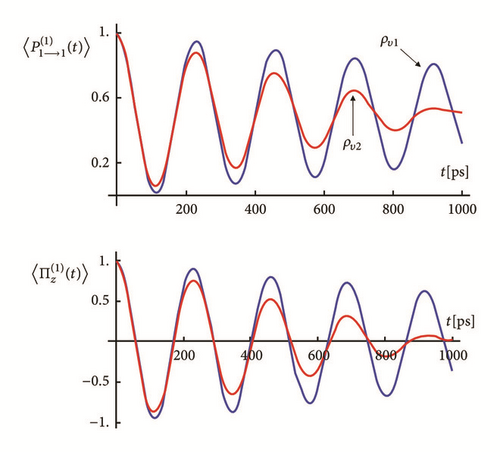


The analytical expressions of the survival probabilities and spin polarizations reported here allow also exploring the behavior of these quantities as functions of the magnetic field. This is the purpose in the next section.
4. The Field Effect on the Spin Polarization
A great amount of experimental research has been published to show the behavior of the spin polarization as function of the magnetic field. Nevertheless, we shall present here the behavior of the thermal averages of the survival probability and the spin polarization , as functions of the magnetic field and time.
In Figure 6 we plot the magnetic field behavior of the survival probabilities and as functions of the magnetic field at t = 1.210−9 and for level density ρυ(ε) = 109ϵs, with s = 0.2. As expected, the survival probability tends to a probability of 1/2 as the magnetic field increases.
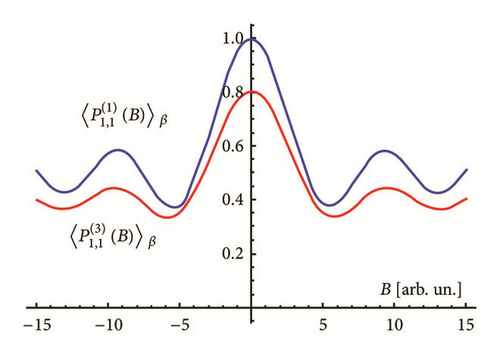
In Figure 7 we show the spin polarization as function of time and of the magnetic field for a level density ρυ(ε) = 109ϵs, with s = 0.2. The oscillating behavior shown in this graph is compatible with the previous results, not only as function of time but also as function of the magnetic field.
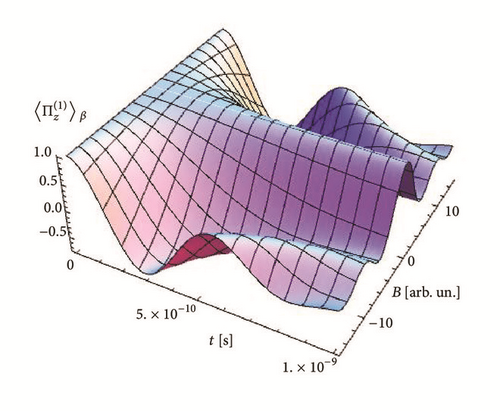
5. Conclusions
We presented here a simple model to study the behavior of a two-level system interacting stochastically with its environment in the presence of a magnetic field in the Faraday configuration. We calculated the survival and spin polarization to first and second order of the interaction picture. We have shown the oscillating evolution of the thermal average of these quantities as function of time and the magnetic field, for different values of the temperature and for the level density ρ(ϵ) ∝ ϵs, in the subohmic, ohmic, and superohmic dissipation forms. We have shown that the spin polarization behavior agrees rather well with the time evolution of the spin polarization observed and calculated, recently, for the electron-nucleus dynamics of Ga centers in dilute (Ga,N)As semiconductors. The calculation of the higher order terms, in the interaction picture, is ongoing and we hope to obtain more accurate results and a better understanding of the oscillating behaviors reported here.
Conflicts of Interest
The author declares that there are no conflicts of interest regarding the publication of this paper.
Acknowledgments
I acknowledge useful comments and corrections of Herbert P. Simanjuntak and A. Robledo-Martinez.
Appendix
Survival Probability and Spin Polarization to Second Order




Open Research
Data Availability
The data used to support the findings of this study are included within the article.




